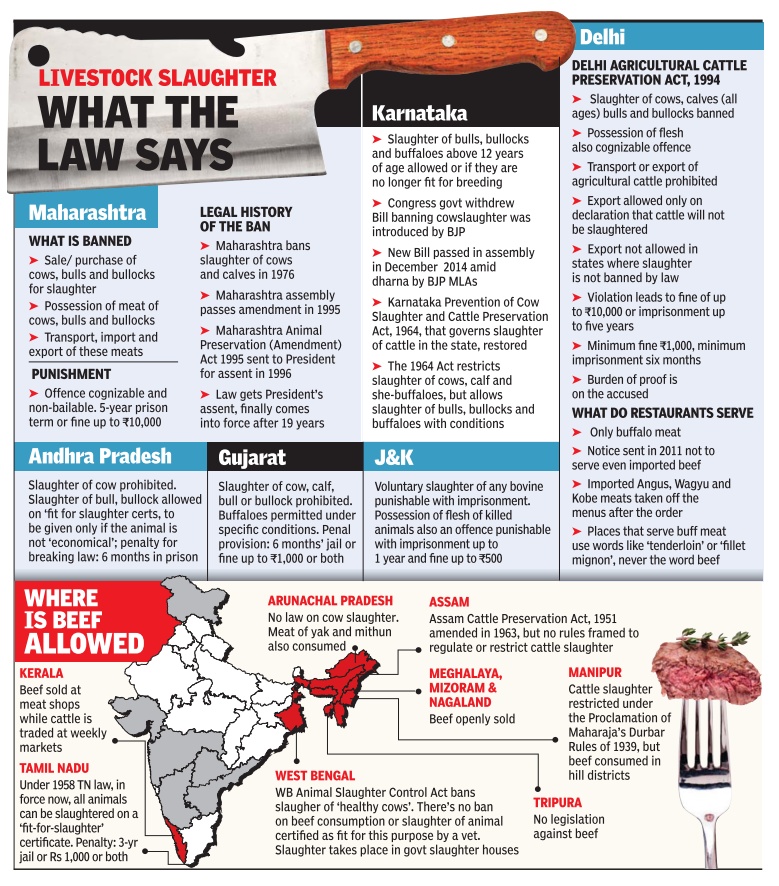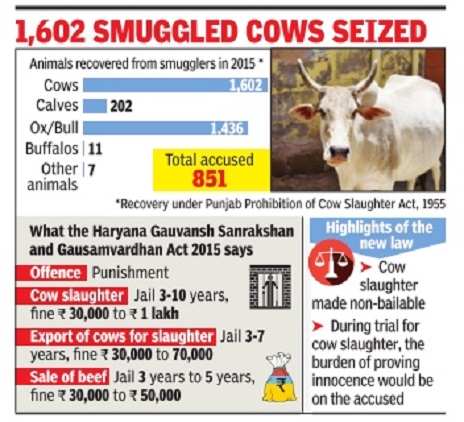Cow slaughter: India
(→Haryana, 2015-16) |
(→Laws, court judgements) |
||
| Line 37: | Line 37: | ||
==Laws on cow slaughter== | ==Laws on cow slaughter== | ||
[http://www.thehindu.com/specials/in-depth/debate-on-beef-ban/article7164886.ece ''The Hindu''], May 2, 2015 | [http://www.thehindu.com/specials/in-depth/debate-on-beef-ban/article7164886.ece ''The Hindu''], May 2, 2015 | ||
| + | [[File: Ban on cow slaughter in India, state-wise.jpg|Ban on cow slaughter in India, state-wise; Graphic courtesy: [http://epaperbeta.timesofindia.com/Gallery.aspx?id=07_05_2016_036_023_002&type=P&artUrl=THE-BULL-SPIRIT-07052016036023&eid=31808 ''The Times of India''], May 7, 2016|frame|500px]] | ||
The Bombay High Court recently upheld the Maharashtra government’s decision to ban sale and consumption of beef in the State. The move has triggered debates across India on vegetarianism, tolerance towards other foods and also whether the State has a right to tell people what they should eat. A look at the debate surrouding the ban and also the consumption of the meat in other parts of the country. | The Bombay High Court recently upheld the Maharashtra government’s decision to ban sale and consumption of beef in the State. The move has triggered debates across India on vegetarianism, tolerance towards other foods and also whether the State has a right to tell people what they should eat. A look at the debate surrouding the ban and also the consumption of the meat in other parts of the country. | ||
| Line 121: | Line 122: | ||
Almost eight months after the Haryana assembly cleared a bill against cow slaughter, it has finally got the President's assent.The law carries a provision of up to 10 years' jail term for offenders. | Almost eight months after the Haryana assembly cleared a bill against cow slaughter, it has finally got the President's assent.The law carries a provision of up to 10 years' jail term for offenders. | ||
The state assembly had in March proposed doubling the current jail term of five years for those found involved in cow slaughter. The bill has also proposed a fine up to Rs 1 lakh for cow slaughter apart from jail term. | The state assembly had in March proposed doubling the current jail term of five years for those found involved in cow slaughter. The bill has also proposed a fine up to Rs 1 lakh for cow slaughter apart from jail term. | ||
| + | |||
=Cow- related crimes= | =Cow- related crimes= | ||
== Haryana, 2015-16== | == Haryana, 2015-16== | ||
Revision as of 21:20, 8 November 2016
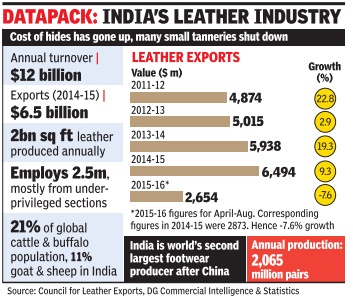

This is a collection of articles archived for the excellence of their content. |
Contents |
10 facts about beef in India
The Times of India, May 29 2015
1 States where cow slaughter is banned: Maharashtra, Haryana, Uttar Pradesh, Tamil Nadu, Rajasthan, Punjab, Odisha, Puducherry, Madhya Pradesh, Karnataka, Jammu & Kashmir, Himachal Pradesh, Gujarat, Delhi, Bihar and Andhra Pradesh
2 Bulls and buffaloes are sold and eaten in most states even where cow slaughter is banned.Karnataka, for example, allows slaughter of bulls and buffaloes above 12 years
3 But some states like Haryana, Rajasthan, Punjab, J&K and Himachal Pradesh have more stringent laws that ban the slaughter of all
4 West Bengal permits slaughter of cows, bulls and buffaloes over the age of 14 but requires a `fit for slaughter' certificate
5 Daman & Diu and Goa permit slaughter of those cows which are old or sick, or for medical purposes
6 Kerala is believed to be India's most beef-friendly state.There is no state legislation banning cow slaughter & dishes like `beef fry' and `beef chilli' are available at roadside stalls too
7 States like Kerala, Manipur, Mizoram, Meghalaya, Arunachal & Nagaland allow slaughter of cattle with no certificate required
8 Despite the bans, India is only second to Brazil when it comes to exporting beef, but most of it is buffalo meat. It is also the fifth-largest producer
9 India's beef ship ments till Oct last year rose to 1.95 million tonnes, 5% more than for the whole of 2013, according to the US department of agriculture
10 It is said that over a quarter of India's population of Scheduled Tribes & Scheduled Castes eat beef. Consumption is also prevalent across all sections of society in states where cow slaughter is legal
Laws, court judgements
Laws on cow slaughter
The Hindu, May 2, 2015
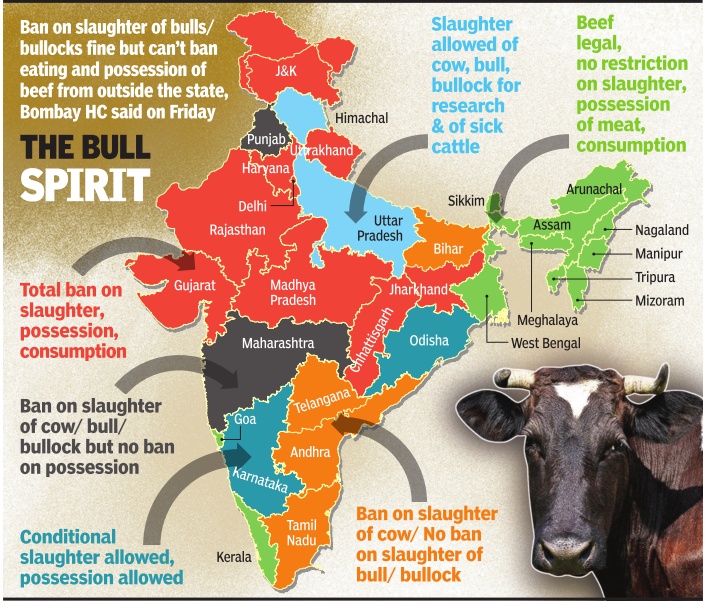
The Bombay High Court recently upheld the Maharashtra government’s decision to ban sale and consumption of beef in the State. The move has triggered debates across India on vegetarianism, tolerance towards other foods and also whether the State has a right to tell people what they should eat. A look at the debate surrouding the ban and also the consumption of the meat in other parts of the country.
Fully banned
Andhra Pradesh, Telangana , Bihar, Chattisgarh, Delhi, Goa, Gujarat, Haryana, Himachal Pradesh, J&K, Jharkhand, Karnataka, Madhya Pradesh, Maharashtra, Punjab, Rajasthan, Uttar Pradesh, Uttarakhand
Allowed with slaughter certificates
Assam, Tamil Nadu, West Bengal
No ban
Arunachal Pradesh, Kerala (animals above 10 years), Manipur, Meghalaya, Mizoram, Nagaland, Sikkim, Tripura
Supreme Court, HCs
Reservations, cow slaughter most frequent cases
The Times of India, Aug 01 2016
Dhananjay Mahapatra
SC protects cows, zealots needn't take law into hands
Vigilante `cow protection' groups taking the law into their hands to assault people for allegedly slaughtering cows is becoming a social as well as law and order problem in many states.Apart from reservation for backward classes, no issue other than cow slaughter has engaged the Supreme Court's repeated attention.
The first recorded judicial refe rence to cow slaughter figures in the Calcutta high court decision in Bhagwan Koer vs J C Bose & Ors [1904 ILR (31) Cal 11]. It was held that “Hindu religion is marvellously catholic and elastic... Its social code is much more stringent, but amongst its different castes and sections, it exhibits wide diversity of practice. No trait is more marked of Hindu society in general than its horror of using meat of the cow“.
Since then, the judiciary has never been able to shake off the cow's constitutional importance.After independence, Congress governments in states enacted laws prohibiting cow slaughter.
In Mohd Hanif Quareshi case [1958 AIR 731], a constitution bench of the SC noticed that Bihar, UP (1955) and Central Provinces and Berar (1949) enacted laws heeding to Article 48 of the Constitution to put a total ban on slaughter of all bovine animals. No exception was made even for bona fide religious purposes.
Validity of these laws was challenged on the ground that mandate of Article 48, a directive principle, would always be inferior to the fundamental right of the petitioner to carry on a business of slaughtering animals under Article 19(1)(g). They also said a total ban violated their fundamental right to religion under Article 25.
The SC had upheld the validity of total ban on cow slaughter. It said, “Protection is confined only to cows and calves and to those animals which are presently or potentially capable of yielding milk or of doing work as draught cattle but does not extend to cattle which at one time were milch or draught cattle but which have ceased to be such. Directive Principles of State Policy set out in Part-IV of the Constitution have to conform to and run as subsidiary to the fundamental rights in Part-III.“
But in Mohd Faruk vs Madhya Pradesh [1969 SCC (1) 853], the SC had said ban on slaughter of bovine animals would not include bulls and bullocks as it would violate fundamental right to carry on a profession. It had said, “A prohibition imposed on exercise of a fundamental right to carry on an occupation will not be regarded as reasonable, if it is imposed not in the interest of the public but merely to respect susceptibilities and sentiments of a sec tion of the people whose way of life, belief or thought is not the same as that of the claimant.“
In Haji Usmanbhai Hasanbhai Qureshi case [1986 (3) SCC 12], the SC had upheld the constitutional validity of Bombay Animal Preservation Act, 1954, imposing a ban on cow slaughter but allowing slaughter of bovine animals above age of 16 years. And the final verdict came from a seven-judge bench in October 2005 in the case Gujarat vs Mirzapur Moti Kureshi, which dealt with validity of Section 2 of the Bombay Animal Preservation (Gujarat Amendment) Act, 1994, introducing certain amendments in Section 5 of the 1954 Act (as applicable to Gujarat).
The bench noticed an SC judgment in West Bengal vs Ashutosh Lahiri [1995 (1) SCC 189] in which it had said, “Sacrifice of any animal by Muslims for religious purpose on Bakri Id does not include slaughtering of cow as the only way of carrying out that sacrifice.An optional religious practice is not covered by Article 25(1).“
In Moti Kureshi case, the SC had said, “On the contrary, it is common knowledge that cow and its progeny are worshipped by Hindus on specified days during Diwali and Makar Sankranti and Gopashtmi. A number of temples are to be found where statue of `Nandi' or `bull' is worshipped.“
It said, “In the light of the material available in abundance before us, there is no escape from the conclusion that the protection conferred by impugned enactment on cow progeny is needed in the interest of nation's economy . Merely because it may cause inconvenience or some dislocation to the butchers, restriction imposed by the impugned enactment does not cease to be in the interest of the public.“
So, there is abundance of law and SC rulings to protect the cow.We certainly don't need vigilante groups to appoint themselves as protectors of the cow. What these groups can do is rescue thousands of cows roaming streets and rehabilitate them in cow shelters .
If these self-styled protectors of cows could open a few hundred gaushalas and shelter homeless cows, they would be doing justice to the constitutional ethos that led to enactment of cow protection laws and subsequent SC rulings.
Bull slaughter: Maharashtra
Maha extends cow slaughter ban to bulls
Mohammed Wajihuddin & Priyanka Kakodkar The Times of India Mar 04 2015
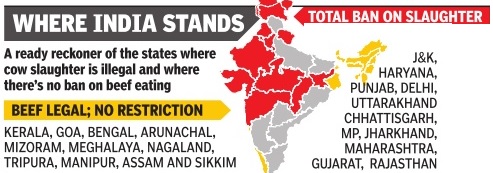

Law Violators Will Face 5-Yr Jail, Rs 10k Fine
Beef-steak and beef chilli fry are going to be off the menus in this world city with Maharashtra's new law which extends the existing ban on cow slaughter to bulls and bullocks.This means that across the state only buffalo meat can be eaten or served, whether it is in the privacy of your home or in a fivestar hotel. Those who violate the law face up to five years in jail and fines up to Rs 10,000.
The fine print of the Maharashtra Animal Preservation (Amendment) Act 1995, which received presidential assent this week, shows just how stringent the ban is. It prohibits the very possession of these meats. Their import and export is banned. So is the transport, sale or purchase of cows, bulls and bullocks for the purpose of slaughter.
Beef is priced at just half the rate of mutton and is the most affordable red meat. It enjoys a large market with roughly 9 lakh kilograms consumed in the city daily .Of this roughly 80% is beef and 20% is buffalo meat, beef traders say . Around 450 large animals are slaughtered daily at the Deonar abbatoir in the city.
The state contributes around 25% to the country's beef and buffalo meat market. Less beef in the market could drive up prices of mutton and chicken, traders say .
Maharashtra had banned the slaughter of cows and calves in 1976. The new law extends the ban to bulls and bullocks. It only excludes female buffaloes and their calves. Several states have already enacted similar laws.
With the “protection of cows and their progeny“ on the BJP's manifesto, the Devendra Fadnavis government actively pushed to get the law enacted. It had been passed by the Maharashtra assembly 19 years ago and was awaiting presidential assent.
2015: Haryana doubles punishment
The Times of India, Nov 13 2015
Sukhbir Siwach
Prez clears Haryana's anti-beef bill
Almost eight months after the Haryana assembly cleared a bill against cow slaughter, it has finally got the President's assent.The law carries a provision of up to 10 years' jail term for offenders. The state assembly had in March proposed doubling the current jail term of five years for those found involved in cow slaughter. The bill has also proposed a fine up to Rs 1 lakh for cow slaughter apart from jail term.
Haryana, 2015-16
Sukhbir Siwach, 1 in 6 booked for cow crimes is Hindu, Oct 26 2016 : The Times of India
513 Cases Filed In Haryana In Eight Months
After coming to power in 2014, the first ever majority BJP government in Haryana led by Manohar Lal Khattar had kept its word and enacted one of the most stringent laws in the country against cow slaughter. As the government completes two years on Wednesday , details obtained by TOI show that in the past eight months, the state police have booked as many 86 Hindus for cow smuggling and other related offences. The number of Muslims booked for similar offences is much higher at 421. Half-a-dozen Sikhs have been booked too. In all 513 people have been booked. The police have compiled the figures of those booked under the Haryana Gauvansh Sanrakshan and Gausamvardhan Act 2015 between January 1 and August 31, 2016. The maximum cases have been registered in con nection with smuggling cows, though, there are some related to cow slaughter and sale of beef as well. As many as 170 people have been arrested.
“We have found that people from across religions are involved in cow smuggling,“ a senior police officer told TOI requesting anonymity . The maximum smuggling cases are in Mewat, Hisar, Fatehabad, Meham, Bhiwani, Rewari, Bhiwani, Mahendergarh, Yamunanagar and Panipat.
The police have also come to know of cow smuggling to Mewat from a gaushala in Jaipur in Rajasthan.
In the past few months the issue has taken centre stage in Haryana's politics. Today , cow activists allege that Hindus are only used by smugglers to transport the bovines. However, others feel that those involved in the trade should not be identified by their religion.
President of the Haryana Rajya Gaushal Sangh, Shamsher Arya says some Hindus are involved in cow smuggling out of greed and unemployment. “However, they only smuggle and are not involved in slaughter,“ says Arya, who has been associated with a campaign for handing over the grazing grounds to gaushalas from panchayats. According to Arya, smugglers tell the villagers that they need cows for milk and offer around Rs 4,000 per animal, including transportation charges.“The Hindus are used for transport so that the police don't arrest them.“
However, a senior farmer leader Gurnam Singh Chaduni points out that due to cow vigilantes, transportation of the animals has become difficult even for genuine buyers. “We have seen that even farmers have been harassed for transporting cows,“ says Chaduni, who is state president of Bharitiya Kisan Union.
“Some people are trying to polarise Hindus and Muslims in Haryana by using this issue,“ says Harphul Khan Bhatti, state president Muslim Kalyan Committee of Haryana. “This whole issue is not religious but a political one. In fact, Muslims respect cows just as the Hindus do.“
Cow vigilantism
2015-16
The Times of India, Jun 21 2016

Cow vigilante groups are now a law unto them selves, assaulting and killing alleged cattle smugglers, gheraoing police stations. Policemen, equally , are at the receiving end of the violence from cattle smugglers.
Since September 2015, when a Muslim was lynched near Dadri on Delhi's outskirts for allegedly possessing cow meat, vigilantism has become rampant, reports from TOI correspondents across states such as Jharkhand, Punjab, Haryana, Rajasthan and UP say .
The shocking incident in Jharkhand's Latehar district, where two alleged cattle traders were thrashed and hanged, made front page news this March. But many cow vigilantism incidents go unnoticed.
Former Jharkhand CM Babulal Marandi sums it up: “In the last six months, harassment of cattle traders has increased manifold. They're beaten up in the name of cow protection. Fear has made many abandon their trade; they're jobless.“
Punjab Dairy Farmers Association president Daljit Singh says vigilantism has affected transportation of cows and adversely impacted diary business. Last April, a video depicting the torture of Punjab cattle smugglers surfaced on social media. Another clip showed Gau Raksha Dal workers flaunting weapons and bulletproof jackets.
Elsewhere, the picture is equally grim. Last month in Rajasthan's Pratapgarh, alleged cattle smugglers were stripped, kicked and tortured in the presence of policemen.Authorities often pamper the cattle protection mobs. On June 6, when over 400 Gau Raksha Dal workers blocked a national highway and gheraoed a police station demanding the release of five vigilantes, senior Pratapgarh police officers transferred SHO Kailash Chand. He'd arrested vigilantes accused of thrashing alleged cow smugglers.
Cow smugglers are no less menacing. On June 3, a chowk idar who tried to rescue cattle was killed allegedly by the smugglers in UP's Azamgarh.Weeks earlier, when police intercepted a truck ferrying cows in Rajasthan's Alwar, the smugglers opened fire.
In this cauldron of violence, rightwing groups are upfront. “If police and administration don't act, others will be forced to. We don't support violence, but cattle smugglers can't have a free run,“ says Sunil Singh, president, Hindu Yuva Vahini (HYV), an outfit founded by Gorakhpur MP Adityanath. HYV's members guard the UP-Bihar border, the route smugglers take for the northeast and Bangladesh.
District president Shiv Sena Muzaffarnagar, Yogender Sharma, claims they tackle two or three cattle smuggling incidents monthly while a local officer concedes: “ At times it's difficult to save culprits from the aggressive Hindu groups.
“We want the cow to be declared Rashtra Mata,“ Jharkhand activist Suresh Ram says. In 2012 he was jailed for assaulting a Muslim who, he claimed, was “a cattle smuggler“. Posters distributed in the eastern state often suggest cattle traders should be hanged.
The police have an unenviable task. UP's DIG Meerut range Laxmi Singh says, “We are vigilant. Cow slaughter creates law and order problems. Special teams have been formed to book those slaughtering cows and the protection groups from taking law into their hands.“
On May 9, Justice Fateh Deep Singh of the Punjab and Haryana high court ordered a CBI probe into the role of vigilante groups. The HC observed: “Such groups have no legal backing... the court cannot shut its eyes and allow state police to give fillip... under the garb of protecting animals.“ Inputs: Palak Nandi, Nitesh Kumar Sharma and Ashis Mehta in Jaipur , Shalabh in Lucknow, Faiz Rahman Siddiqui in Kanpur , Arvind Chauhan in Agra, Binay Singh in Varanasi, IP Singh in Jalandhar , Alok Mishra in Ranchi, Suchandana Gupta in Bhopal
Sep 2015- July 2016: Violent attacks by gau rakshaks
The Times of India, 6 Aug, 2016
Some instances of violent attacks perpetrated by gau rakshaks.
1. July 2016 - Mandasur, Madhya Pradesh
In June 2016, two Muslim women from Mandasur in Madhya Pradesh were beaten by gau rakshaks who suspected them of transporting beef for sale. The incident, which took place at a railway station, was filmed.
After the incident, lawyer Prashant Bhushan, once a member of the Team Anna movement, tweeted that the vigilantes' behavior was "goondaism", and that "jungle raj" was "fast spreading in BJP states."
2. July 2016 - Una, Gujarat
On July 11, four Dalit men from a village near Una in Gir province were skinning dead cows. After rumours spread that they were slaughtering them, members of the local Shiv Sena stripped them half-naked, tied them to an SUV, and beat publicly. The incident sparked Dalit protests across the state of Gujarat, and former Gujarat CM Anandiben Patel called for peace. "People with with vested political interests are trying to divide communities and disrupt peace in state," she alleged.
3. June 2016 - NCR
In June 2016, a video surfaced showing two young Muslim men sitting in the middle of the road, trying to ingest a substance in a packet. Shouts of "Gau Mata Ki Jai" and "Jai Shri Ram" could be heard in the background. Reports said the substance was a mixture of cow excrement and dairy products, and that the gau rakshaks who had filmed the video had found beef in the two men's car.
4. May 2016 - Amreli, Gujarat
On May 22, 2016, Seven Dalits were beaten for two and a half hours by more than 30 cow vigilantes in Amreli in Gujarat. The men were reportedly skinning dead cows, but rumours had spread that they were killing them. Their assailants used iron pipes, baseball bats, and swords to hit them. The victims later alleged that the gau rakshaks had planned to burn them alive, and that members of their community had managed to come to their rescue in the nick of time.
Thirteen arrests were made in connection with the incident in July, after the Una attack.
5. September 2015 - Dadri, Uttar Pradesh
On September 28, 2015, Mohammed Akhlaq, a resident of Bisada village in Greater Noida, was beaten to death by a lynch mob. His son was attacked too, and sustained serious injuries. The mob carried out the attack after it was announced at a nearby temple that Akhlaq's family had eaten beef. It was also claimed that there was beef in their house. However, investigations revealed that they had mutton in their fridge, not beef.
Muslim opposition to cow slaughter
Early 1900s: Maulanas issue fatwas against cow slaughter
Voices that put harmony over discord
Prior to Maulana Abdul Bari Ferangi Mahali, his ancestors had twice issued appeals to their followers against cow slaughter on Bakrid, declaring that it was not an obligation under Islam. In the early 1900s, Maulana Abdul Hai Ferangi Mahali (Bari's cousin), Maulana Abdul Wahab (Bari's father), Qazi Syed Mohammad Hasan, and Maulana Abul Haya Mohammad Abdul Hameed had issued fatwas stating cow slaughter is not obligatory and those giving it up will not be sinners--as mentioned in `Tark-e-Qurbani-e-Gao', the book by Khwaja Hasan Nizami Dehelvi printed in August 1921. In 1911, Maulana Hai and Maulana Wahab signed another fatwa stating that if cow slaughter hurts sentiments and creates disharmony, it should be given up, for it is not a part of Islamic law.
Early 1900s Lucknow: Maulana Abdul Bari’s decision
Lucknow's Muslims said no to cow killing 100 years ago, TNN | Sep 12, 2016, The Times of India
Adnan Abdul Wali, a descendant of Maulana Abdul Bari Ferangi Mahali in the cityAdnan Abdul Wali, a descendant of Maulana Abdul Bari Ferangi Mahali in the city
LUCKNOW: Muslims in Lucknow had voluntarily given up cow slaughter on Eid-ul-Zuha (Bakrid) almost a century ago, long before the Uttar Pradesh Prevention of Cow Slaughter Act of 1955 was even thought of.
The practice that has been kept alive ever since, was also validated by the Sri Dharma Bharat Mahamandal, established in 1887 by Pandit Madan Mohan Malviya, and by Mahatma Gandhi in his letter to the Mumbai edition of the Times of India on September 6, 1919.
Under the leadership of Maulana Abdul Bari Ferangi Mahali, a freedom fighter and prominent figure of the Khilafat Movement along with the Ali brothers, a wave of abstinence from cow slaughter during Bakrid started to build. Previous efforts had also been made by Bari's ancestors, but were marred time and again.
Penning his conversation with Maulana Bari, Mahatma Gandhi (who referred to Bari as his brother) in his letter to TOI also emphasised how the step was unconditional and how the Maulana enjoyed massive following, even though Hindus were unwilling to support the Khilafat movement. And as the Mahatma writes, true to his word, the Maulana after his conversation with Gandhi, started "preaching amongst his followers and friends the necessity of abstaining from cow-killing." That very day in 1919, Gandhi had also received a telegram from Maulana Bari (that is referred to in the letter) stating: "In celebration of Hindu-Muslim unity, no cow sacrifices in Ferangi Mahal this Baqreid-Abdul Bari."
And not just in Ferangi Mahal, a letter to Maulana Bari on January 10, 1920 from the Sri Bharat Dharma Mahamandal thanked him profusely for his "efforts through speech and abstention himself, that in the days of Baqreid there was no cow-killing in Lucknow."
A Sufi and an Aalim (scholar), as author and historian, Gail Minault wrote in her book 'The Khilafat Movement', Bari had "religious influence over a variety of followers, and a large group of disciples from the Northwest to Bengal to Madras."
But it was not out of pressure that the unifying step was adopted by Muslims under his leadership. In his speech at a Hindu-Muslim conference on January 15, 1920 in Saharanpur, Maulana Bari had said, "No Hindus, nor Mahatma Gandhi have requested me to stop cow slaughter, but with my own heartfelt desire for unity and not to hurt the sentiments of my Hindu brothers, I have stopped doing so."
Later, following Bari's footsteps, some senior members of the Muslim League had also agreed to avoid cow slaughter during Bakrid in other parts of the state too.
